Mining Hazards and Accident Management in the Mining Industry
VerifiedAdded on 2023/03/30
|14
|2555
|172
AI Summary
This paper discusses the hazards in the mining industry and provides procedures to be followed in case of accidents. It covers topics such as dust control, noise control, and wastewater management. The focus is on reducing risks and ensuring safety in the mining industry.
Contribute Materials
Your contribution can guide someone’s learning journey. Share your
documents today.
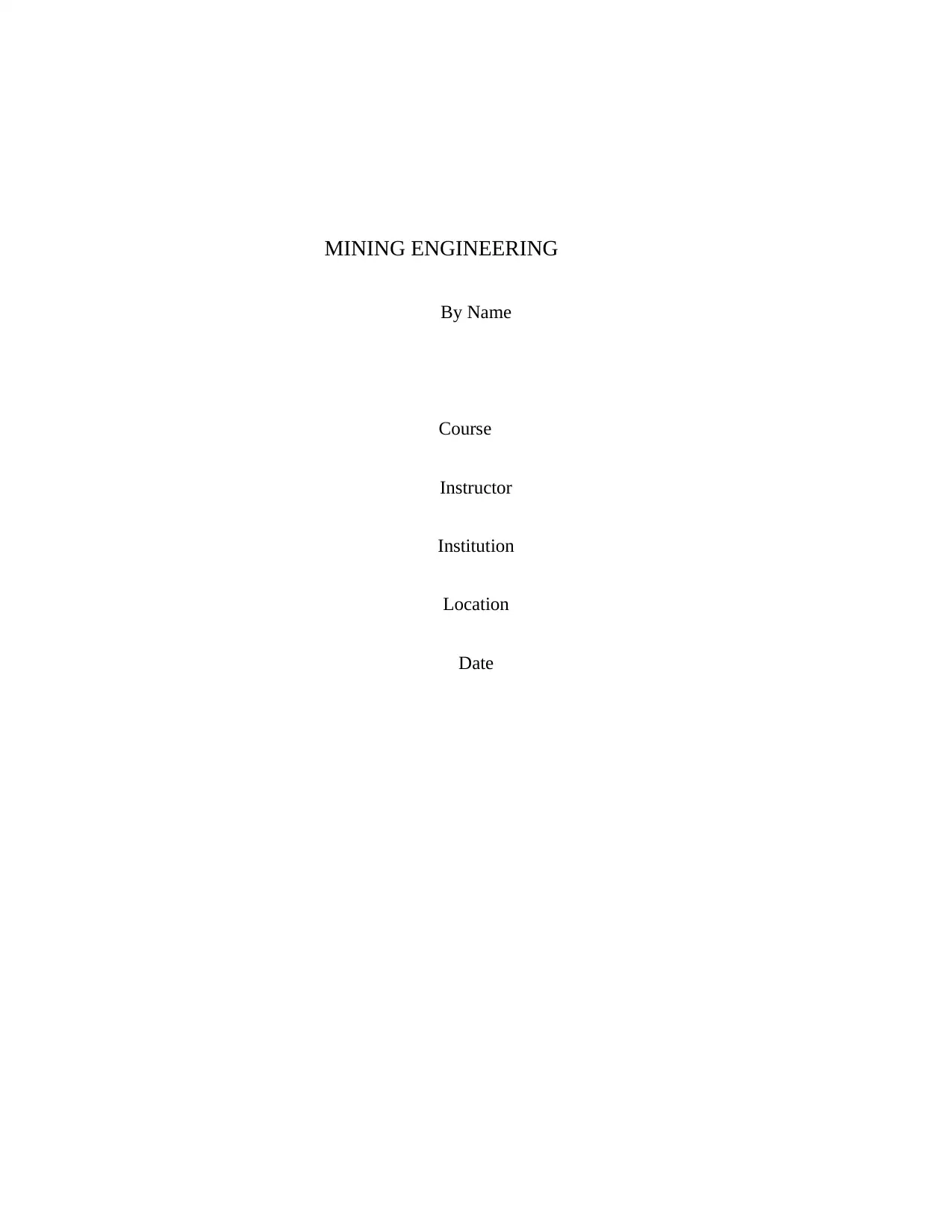
MINING ENGINEERING
By Name
Course
Instructor
Institution
Location
Date
By Name
Course
Instructor
Institution
Location
Date
Secure Best Marks with AI Grader
Need help grading? Try our AI Grader for instant feedback on your assignments.
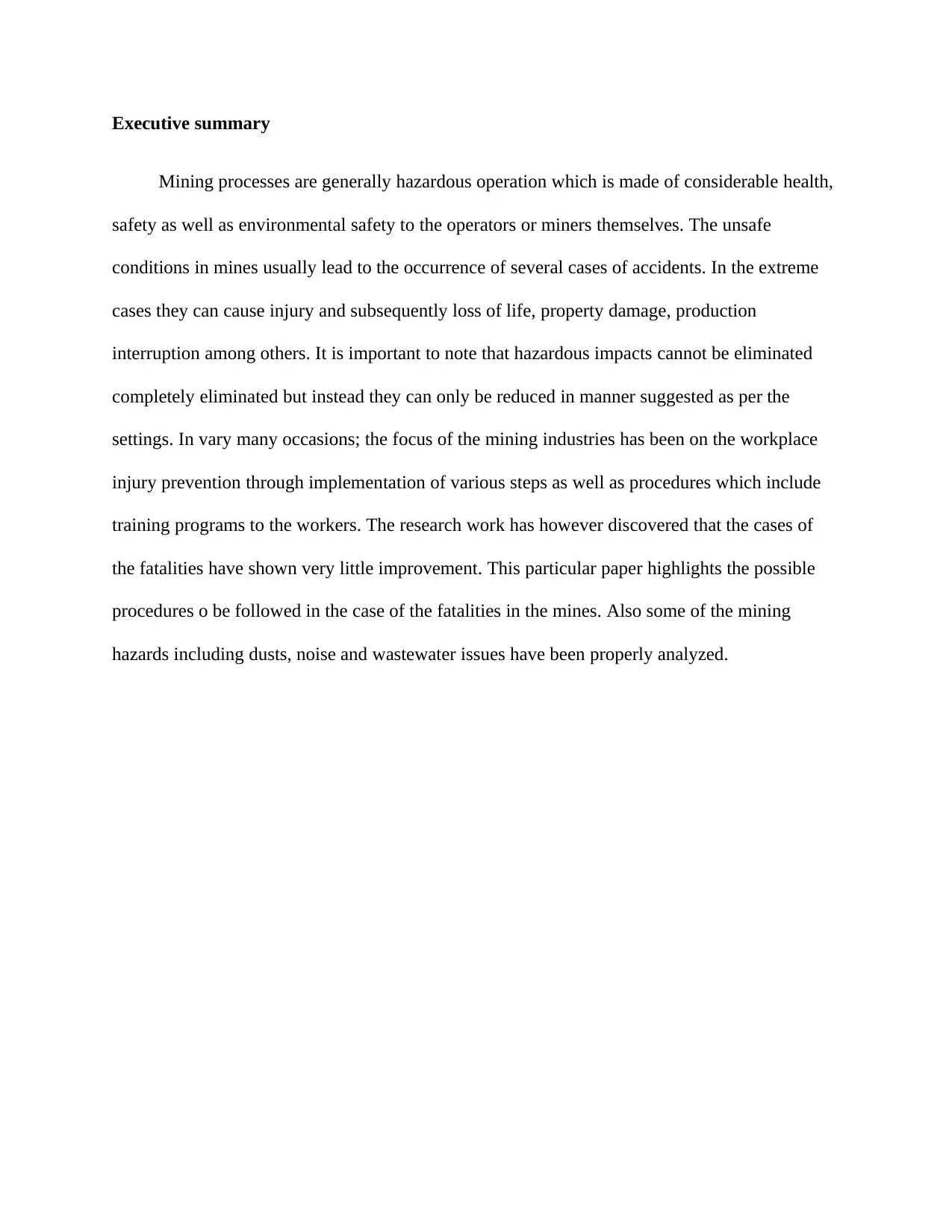
Executive summary
Mining processes are generally hazardous operation which is made of considerable health,
safety as well as environmental safety to the operators or miners themselves. The unsafe
conditions in mines usually lead to the occurrence of several cases of accidents. In the extreme
cases they can cause injury and subsequently loss of life, property damage, production
interruption among others. It is important to note that hazardous impacts cannot be eliminated
completely eliminated but instead they can only be reduced in manner suggested as per the
settings. In vary many occasions; the focus of the mining industries has been on the workplace
injury prevention through implementation of various steps as well as procedures which include
training programs to the workers. The research work has however discovered that the cases of
the fatalities have shown very little improvement. This particular paper highlights the possible
procedures o be followed in the case of the fatalities in the mines. Also some of the mining
hazards including dusts, noise and wastewater issues have been properly analyzed.
Mining processes are generally hazardous operation which is made of considerable health,
safety as well as environmental safety to the operators or miners themselves. The unsafe
conditions in mines usually lead to the occurrence of several cases of accidents. In the extreme
cases they can cause injury and subsequently loss of life, property damage, production
interruption among others. It is important to note that hazardous impacts cannot be eliminated
completely eliminated but instead they can only be reduced in manner suggested as per the
settings. In vary many occasions; the focus of the mining industries has been on the workplace
injury prevention through implementation of various steps as well as procedures which include
training programs to the workers. The research work has however discovered that the cases of
the fatalities have shown very little improvement. This particular paper highlights the possible
procedures o be followed in the case of the fatalities in the mines. Also some of the mining
hazards including dusts, noise and wastewater issues have been properly analyzed.

Introduction
Management of accident is very crucial in any industry so as to enhance efficiency. The
mining industry is one such industry which requires proper management of risks as well as
hazards. The occurrence of hazards in the mining sites is usually regarded to be very expensive
in terms of the cost. The risk of the mine workers being exposed to specks of dust particles
which might be regarded as hazardous should be properly controlled just to ensure that
sustainable operations are realized. The control procedures should consider sequential
procedures(Rebello et al 2016).Horizon Company does not work in isolation either. It will be
subjected to the challenges of dust control, wastewater management as wells regulation of the
noise level in the entire mining site. In order to ensure that these issues, this particular paper has
provided a specific outline that is meant to guide the company while highlighting the legal
responsibilities pursuant to Queensland Coal Mining regulation on mining safety and procedural
requirements. The focus has been directed to dust control, wastewater management and finally
noise level control(Walters et al 2016).
DUST
Different bodies concerned with the health and safety management in coal mining should
provide control measures for dust control. This can be done through;
- Safeguarding the level of exposure to dust by the workers in the coal mines.
- Ensuring that the workers at the coal mines do not breathe the dust above a given
concentration for a period of more than 8 hours as stipulated in provision of 89A (1) of
Queensland Regulations.
Management of accident is very crucial in any industry so as to enhance efficiency. The
mining industry is one such industry which requires proper management of risks as well as
hazards. The occurrence of hazards in the mining sites is usually regarded to be very expensive
in terms of the cost. The risk of the mine workers being exposed to specks of dust particles
which might be regarded as hazardous should be properly controlled just to ensure that
sustainable operations are realized. The control procedures should consider sequential
procedures(Rebello et al 2016).Horizon Company does not work in isolation either. It will be
subjected to the challenges of dust control, wastewater management as wells regulation of the
noise level in the entire mining site. In order to ensure that these issues, this particular paper has
provided a specific outline that is meant to guide the company while highlighting the legal
responsibilities pursuant to Queensland Coal Mining regulation on mining safety and procedural
requirements. The focus has been directed to dust control, wastewater management and finally
noise level control(Walters et al 2016).
DUST
Different bodies concerned with the health and safety management in coal mining should
provide control measures for dust control. This can be done through;
- Safeguarding the level of exposure to dust by the workers in the coal mines.
- Ensuring that the workers at the coal mines do not breathe the dust above a given
concentration for a period of more than 8 hours as stipulated in provision of 89A (1) of
Queensland Regulations.
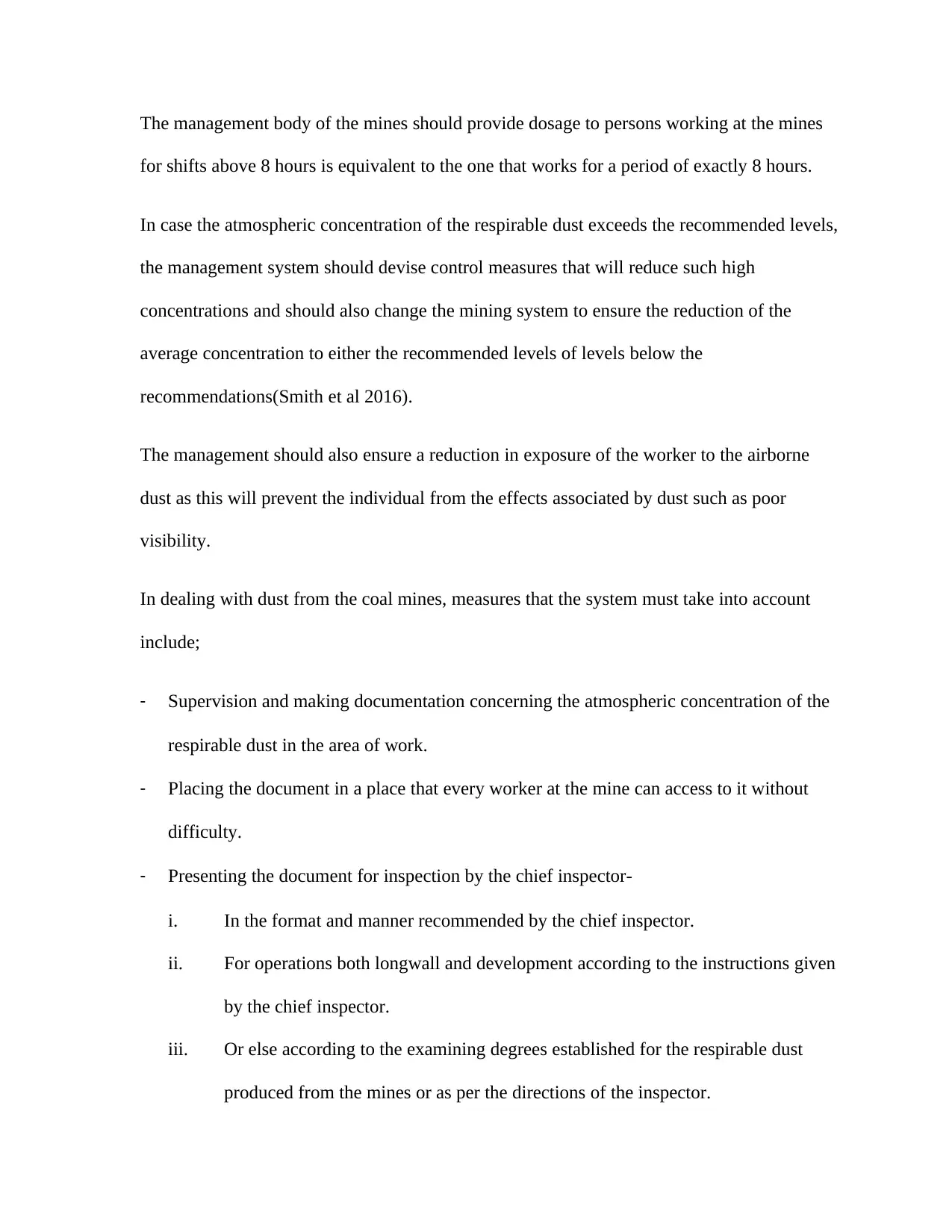
The management body of the mines should provide dosage to persons working at the mines
for shifts above 8 hours is equivalent to the one that works for a period of exactly 8 hours.
In case the atmospheric concentration of the respirable dust exceeds the recommended levels,
the management system should devise control measures that will reduce such high
concentrations and should also change the mining system to ensure the reduction of the
average concentration to either the recommended levels of levels below the
recommendations(Smith et al 2016).
The management should also ensure a reduction in exposure of the worker to the airborne
dust as this will prevent the individual from the effects associated by dust such as poor
visibility.
In dealing with dust from the coal mines, measures that the system must take into account
include;
- Supervision and making documentation concerning the atmospheric concentration of the
respirable dust in the area of work.
- Placing the document in a place that every worker at the mine can access to it without
difficulty.
- Presenting the document for inspection by the chief inspector-
i. In the format and manner recommended by the chief inspector.
ii. For operations both longwall and development according to the instructions given
by the chief inspector.
iii. Or else according to the examining degrees established for the respirable dust
produced from the mines or as per the directions of the inspector.
for shifts above 8 hours is equivalent to the one that works for a period of exactly 8 hours.
In case the atmospheric concentration of the respirable dust exceeds the recommended levels,
the management system should devise control measures that will reduce such high
concentrations and should also change the mining system to ensure the reduction of the
average concentration to either the recommended levels of levels below the
recommendations(Smith et al 2016).
The management should also ensure a reduction in exposure of the worker to the airborne
dust as this will prevent the individual from the effects associated by dust such as poor
visibility.
In dealing with dust from the coal mines, measures that the system must take into account
include;
- Supervision and making documentation concerning the atmospheric concentration of the
respirable dust in the area of work.
- Placing the document in a place that every worker at the mine can access to it without
difficulty.
- Presenting the document for inspection by the chief inspector-
i. In the format and manner recommended by the chief inspector.
ii. For operations both longwall and development according to the instructions given
by the chief inspector.
iii. Or else according to the examining degrees established for the respirable dust
produced from the mines or as per the directions of the inspector.
Secure Best Marks with AI Grader
Need help grading? Try our AI Grader for instant feedback on your assignments.
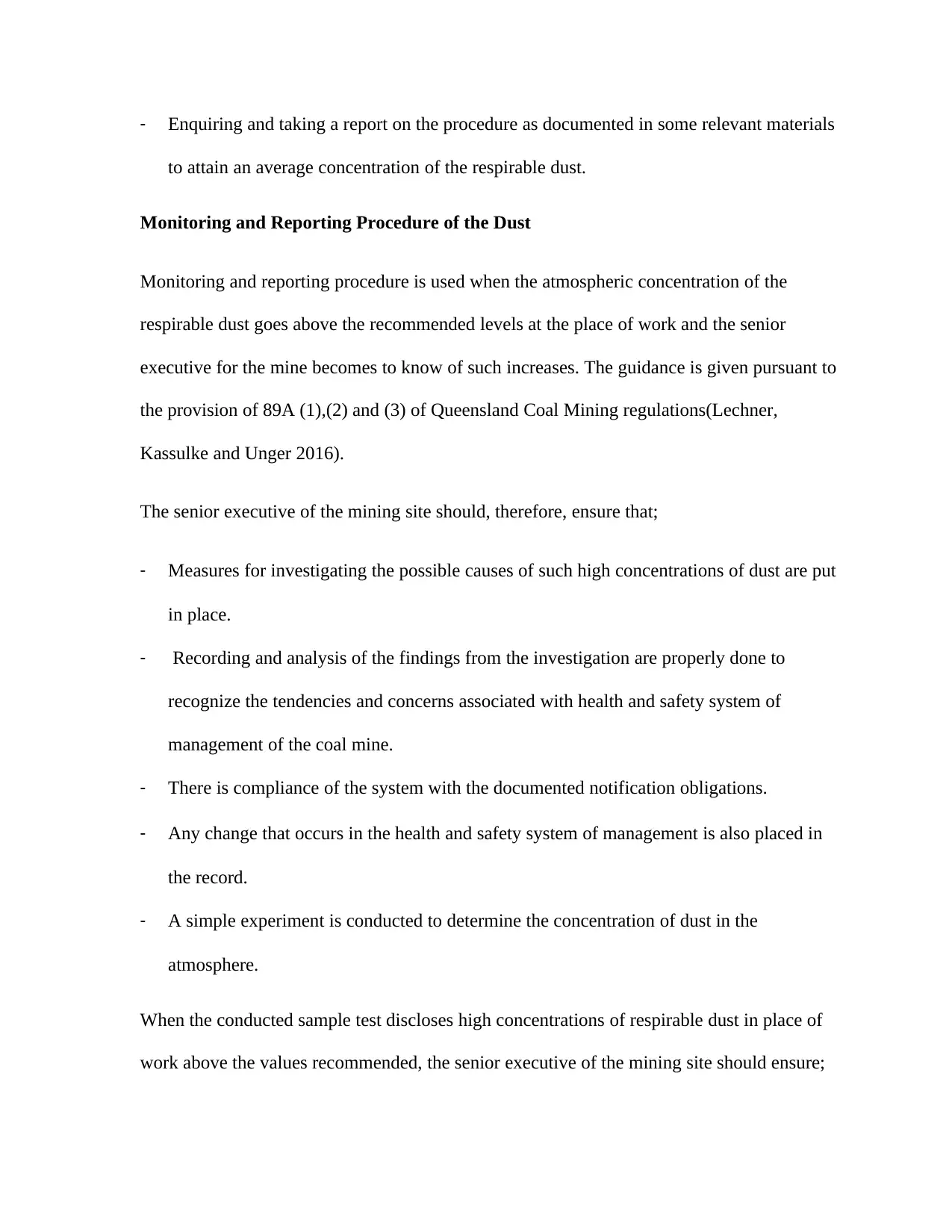
- Enquiring and taking a report on the procedure as documented in some relevant materials
to attain an average concentration of the respirable dust.
Monitoring and Reporting Procedure of the Dust
Monitoring and reporting procedure is used when the atmospheric concentration of the
respirable dust goes above the recommended levels at the place of work and the senior
executive for the mine becomes to know of such increases. The guidance is given pursuant to
the provision of 89A (1),(2) and (3) of Queensland Coal Mining regulations(Lechner,
Kassulke and Unger 2016).
The senior executive of the mining site should, therefore, ensure that;
- Measures for investigating the possible causes of such high concentrations of dust are put
in place.
- Recording and analysis of the findings from the investigation are properly done to
recognize the tendencies and concerns associated with health and safety system of
management of the coal mine.
- There is compliance of the system with the documented notification obligations.
- Any change that occurs in the health and safety system of management is also placed in
the record.
- A simple experiment is conducted to determine the concentration of dust in the
atmosphere.
When the conducted sample test discloses high concentrations of respirable dust in place of
work above the values recommended, the senior executive of the mining site should ensure;
to attain an average concentration of the respirable dust.
Monitoring and Reporting Procedure of the Dust
Monitoring and reporting procedure is used when the atmospheric concentration of the
respirable dust goes above the recommended levels at the place of work and the senior
executive for the mine becomes to know of such increases. The guidance is given pursuant to
the provision of 89A (1),(2) and (3) of Queensland Coal Mining regulations(Lechner,
Kassulke and Unger 2016).
The senior executive of the mining site should, therefore, ensure that;
- Measures for investigating the possible causes of such high concentrations of dust are put
in place.
- Recording and analysis of the findings from the investigation are properly done to
recognize the tendencies and concerns associated with health and safety system of
management of the coal mine.
- There is compliance of the system with the documented notification obligations.
- Any change that occurs in the health and safety system of management is also placed in
the record.
- A simple experiment is conducted to determine the concentration of dust in the
atmosphere.
When the conducted sample test discloses high concentrations of respirable dust in place of
work above the values recommended, the senior executive of the mining site should ensure;

- An investigation of the persistent increase in the concentration of the respirable dust.
- Further recording and analysis of the investigated results to recognize the tendencies and
concerns associated with health and safety system of management at the coal mine.
- Compliance with the notification obligations of the document.
- Further recording of the possible changes that occur in the health and safety system of
management.
In practices to control the levels of dust, the workers in the coal mines who are at risk of
exposure to dust should be made aware of the effects of high concentrations of respirable dust.
Noise Control
Noise can be defined as the sound which is undesirable and it is usually considered as a by-
product in most of the mining industries. The horizon mining industry will not be an exception in
this case. Most of the minors are exposed to a loud level of the noise which is also
sustained(Pearse 2016). Majority of the equipment that is used in the process of mining is the
one which is used in the process of mining. The excavators that have a lower capacity of
operation, as well as other machines which a diesel based, are some of the primary sources of the
noise pollution at the mining site of the Horizon mining company. The other machines include
stage loaders, mixers, compressors, shearers, pneumatic drilling machine, and fans contribute to
the excessive noise in the underground mining. Horizon mining company should consider
making the necessary arrangements which will include compliance with the Queensland
regulation in regard to the noise level requirement(Towler et al 2016).
- Further recording and analysis of the investigated results to recognize the tendencies and
concerns associated with health and safety system of management at the coal mine.
- Compliance with the notification obligations of the document.
- Further recording of the possible changes that occur in the health and safety system of
management.
In practices to control the levels of dust, the workers in the coal mines who are at risk of
exposure to dust should be made aware of the effects of high concentrations of respirable dust.
Noise Control
Noise can be defined as the sound which is undesirable and it is usually considered as a by-
product in most of the mining industries. The horizon mining industry will not be an exception in
this case. Most of the minors are exposed to a loud level of the noise which is also
sustained(Pearse 2016). Majority of the equipment that is used in the process of mining is the
one which is used in the process of mining. The excavators that have a lower capacity of
operation, as well as other machines which a diesel based, are some of the primary sources of the
noise pollution at the mining site of the Horizon mining company. The other machines include
stage loaders, mixers, compressors, shearers, pneumatic drilling machine, and fans contribute to
the excessive noise in the underground mining. Horizon mining company should consider
making the necessary arrangements which will include compliance with the Queensland
regulation in regard to the noise level requirement(Towler et al 2016).

According to Queensland regulations on the mining, the safety as well as health management
system must always provide mechanism which function to ensure that: The exposure of each and
every worker of the coal mine exposure to the noise level is reduced or kept to the levels that are
acceptable. Also, the worker should never be exposed to the level of noise which exceeds the
stated levels in the standards of the national occupational noise(Orellana et al 2018). The system
that is put in place for utilization will include supplying the equipment of personal protection in
the environment where work is being carried out. This will be recommended in the cases where
there is no way considered practical as far the noise reduction is concerned. This will ensure
compliance with full compliance with subsection1.
Recording as well as monitoring of the level of noise in the work environment
Keeping the records in a location that is easily accessible by any worker at the coal mine
as for reference.
Identification of an appropriate sign to be used for warning in each and every part of the
mining site where higher levels of noise are likely to be experienced.
The other recommendations in regard to the control of the noise will include:
Reduction of the hours of exposure to the areas with excess sound production through
proper administrative work shift organization.
The management can consider practicing what is referred to as the work rotation.
Organization of workers training on the use of the PPPs besides explaining their
advantages
The mine workers should undergo compulsory medical inspection in regard to their
ability to hear.
system must always provide mechanism which function to ensure that: The exposure of each and
every worker of the coal mine exposure to the noise level is reduced or kept to the levels that are
acceptable. Also, the worker should never be exposed to the level of noise which exceeds the
stated levels in the standards of the national occupational noise(Orellana et al 2018). The system
that is put in place for utilization will include supplying the equipment of personal protection in
the environment where work is being carried out. This will be recommended in the cases where
there is no way considered practical as far the noise reduction is concerned. This will ensure
compliance with full compliance with subsection1.
Recording as well as monitoring of the level of noise in the work environment
Keeping the records in a location that is easily accessible by any worker at the coal mine
as for reference.
Identification of an appropriate sign to be used for warning in each and every part of the
mining site where higher levels of noise are likely to be experienced.
The other recommendations in regard to the control of the noise will include:
Reduction of the hours of exposure to the areas with excess sound production through
proper administrative work shift organization.
The management can consider practicing what is referred to as the work rotation.
Organization of workers training on the use of the PPPs besides explaining their
advantages
The mine workers should undergo compulsory medical inspection in regard to their
ability to hear.
Paraphrase This Document
Need a fresh take? Get an instant paraphrase of this document with our AI Paraphraser
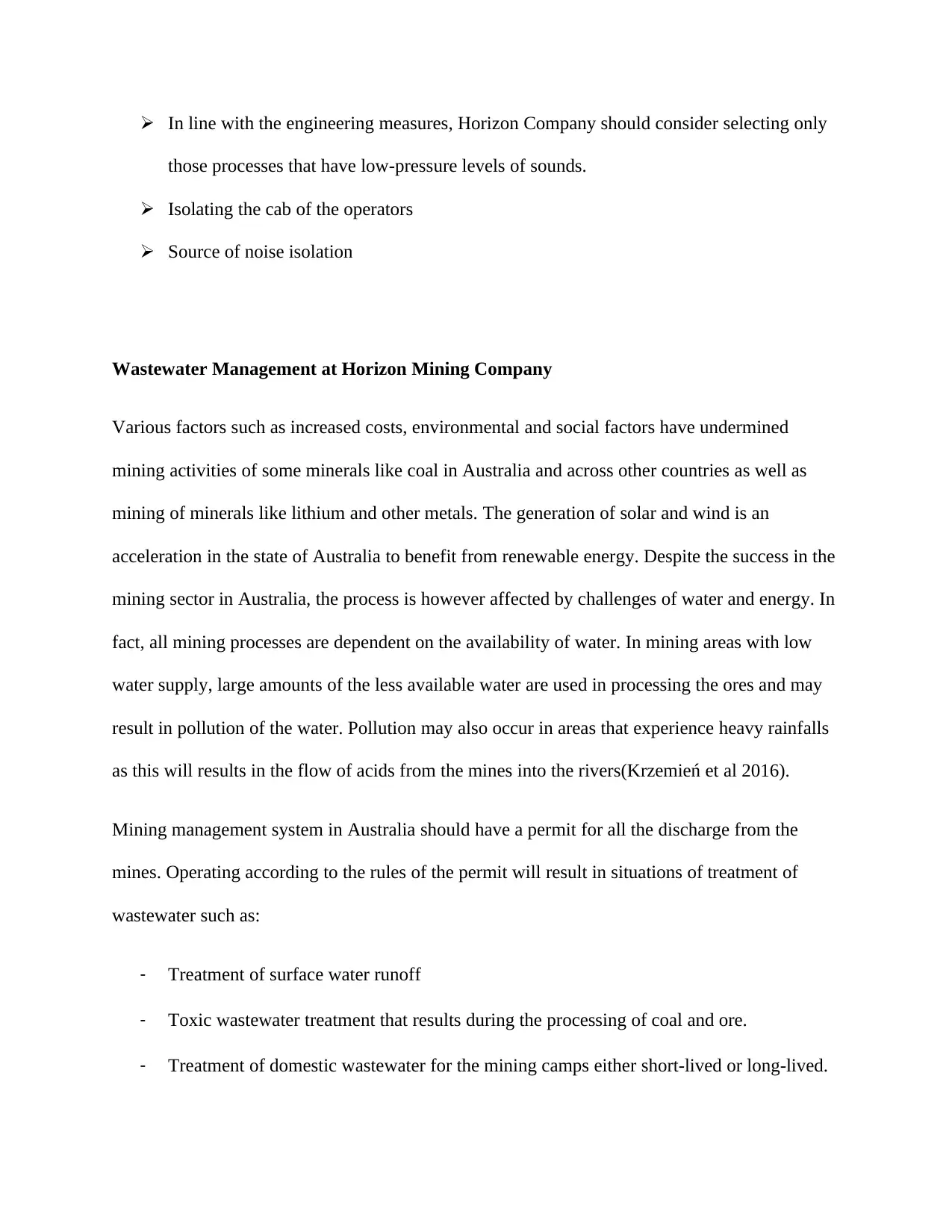
In line with the engineering measures, Horizon Company should consider selecting only
those processes that have low-pressure levels of sounds.
Isolating the cab of the operators
Source of noise isolation
Wastewater Management at Horizon Mining Company
Various factors such as increased costs, environmental and social factors have undermined
mining activities of some minerals like coal in Australia and across other countries as well as
mining of minerals like lithium and other metals. The generation of solar and wind is an
acceleration in the state of Australia to benefit from renewable energy. Despite the success in the
mining sector in Australia, the process is however affected by challenges of water and energy. In
fact, all mining processes are dependent on the availability of water. In mining areas with low
water supply, large amounts of the less available water are used in processing the ores and may
result in pollution of the water. Pollution may also occur in areas that experience heavy rainfalls
as this will results in the flow of acids from the mines into the rivers(Krzemień et al 2016).
Mining management system in Australia should have a permit for all the discharge from the
mines. Operating according to the rules of the permit will result in situations of treatment of
wastewater such as:
- Treatment of surface water runoff
- Toxic wastewater treatment that results during the processing of coal and ore.
- Treatment of domestic wastewater for the mining camps either short-lived or long-lived.
those processes that have low-pressure levels of sounds.
Isolating the cab of the operators
Source of noise isolation
Wastewater Management at Horizon Mining Company
Various factors such as increased costs, environmental and social factors have undermined
mining activities of some minerals like coal in Australia and across other countries as well as
mining of minerals like lithium and other metals. The generation of solar and wind is an
acceleration in the state of Australia to benefit from renewable energy. Despite the success in the
mining sector in Australia, the process is however affected by challenges of water and energy. In
fact, all mining processes are dependent on the availability of water. In mining areas with low
water supply, large amounts of the less available water are used in processing the ores and may
result in pollution of the water. Pollution may also occur in areas that experience heavy rainfalls
as this will results in the flow of acids from the mines into the rivers(Krzemień et al 2016).
Mining management system in Australia should have a permit for all the discharge from the
mines. Operating according to the rules of the permit will result in situations of treatment of
wastewater such as:
- Treatment of surface water runoff
- Toxic wastewater treatment that results during the processing of coal and ore.
- Treatment of domestic wastewater for the mining camps either short-lived or long-lived.
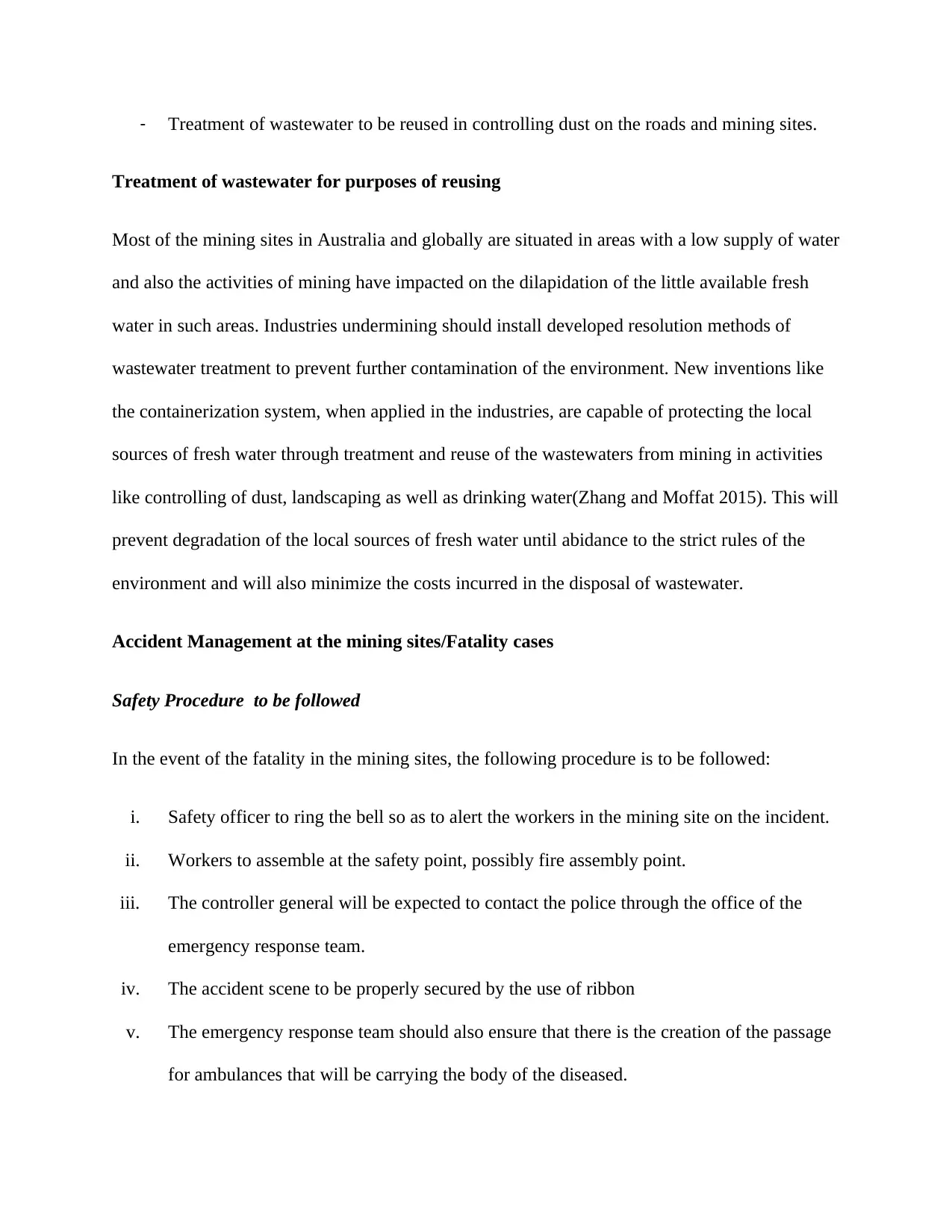
- Treatment of wastewater to be reused in controlling dust on the roads and mining sites.
Treatment of wastewater for purposes of reusing
Most of the mining sites in Australia and globally are situated in areas with a low supply of water
and also the activities of mining have impacted on the dilapidation of the little available fresh
water in such areas. Industries undermining should install developed resolution methods of
wastewater treatment to prevent further contamination of the environment. New inventions like
the containerization system, when applied in the industries, are capable of protecting the local
sources of fresh water through treatment and reuse of the wastewaters from mining in activities
like controlling of dust, landscaping as well as drinking water(Zhang and Moffat 2015). This will
prevent degradation of the local sources of fresh water until abidance to the strict rules of the
environment and will also minimize the costs incurred in the disposal of wastewater.
Accident Management at the mining sites/Fatality cases
Safety Procedure to be followed
In the event of the fatality in the mining sites, the following procedure is to be followed:
i. Safety officer to ring the bell so as to alert the workers in the mining site on the incident.
ii. Workers to assemble at the safety point, possibly fire assembly point.
iii. The controller general will be expected to contact the police through the office of the
emergency response team.
iv. The accident scene to be properly secured by the use of ribbon
v. The emergency response team should also ensure that there is the creation of the passage
for ambulances that will be carrying the body of the diseased.
Treatment of wastewater for purposes of reusing
Most of the mining sites in Australia and globally are situated in areas with a low supply of water
and also the activities of mining have impacted on the dilapidation of the little available fresh
water in such areas. Industries undermining should install developed resolution methods of
wastewater treatment to prevent further contamination of the environment. New inventions like
the containerization system, when applied in the industries, are capable of protecting the local
sources of fresh water through treatment and reuse of the wastewaters from mining in activities
like controlling of dust, landscaping as well as drinking water(Zhang and Moffat 2015). This will
prevent degradation of the local sources of fresh water until abidance to the strict rules of the
environment and will also minimize the costs incurred in the disposal of wastewater.
Accident Management at the mining sites/Fatality cases
Safety Procedure to be followed
In the event of the fatality in the mining sites, the following procedure is to be followed:
i. Safety officer to ring the bell so as to alert the workers in the mining site on the incident.
ii. Workers to assemble at the safety point, possibly fire assembly point.
iii. The controller general will be expected to contact the police through the office of the
emergency response team.
iv. The accident scene to be properly secured by the use of ribbon
v. The emergency response team should also ensure that there is the creation of the passage
for ambulances that will be carrying the body of the diseased.
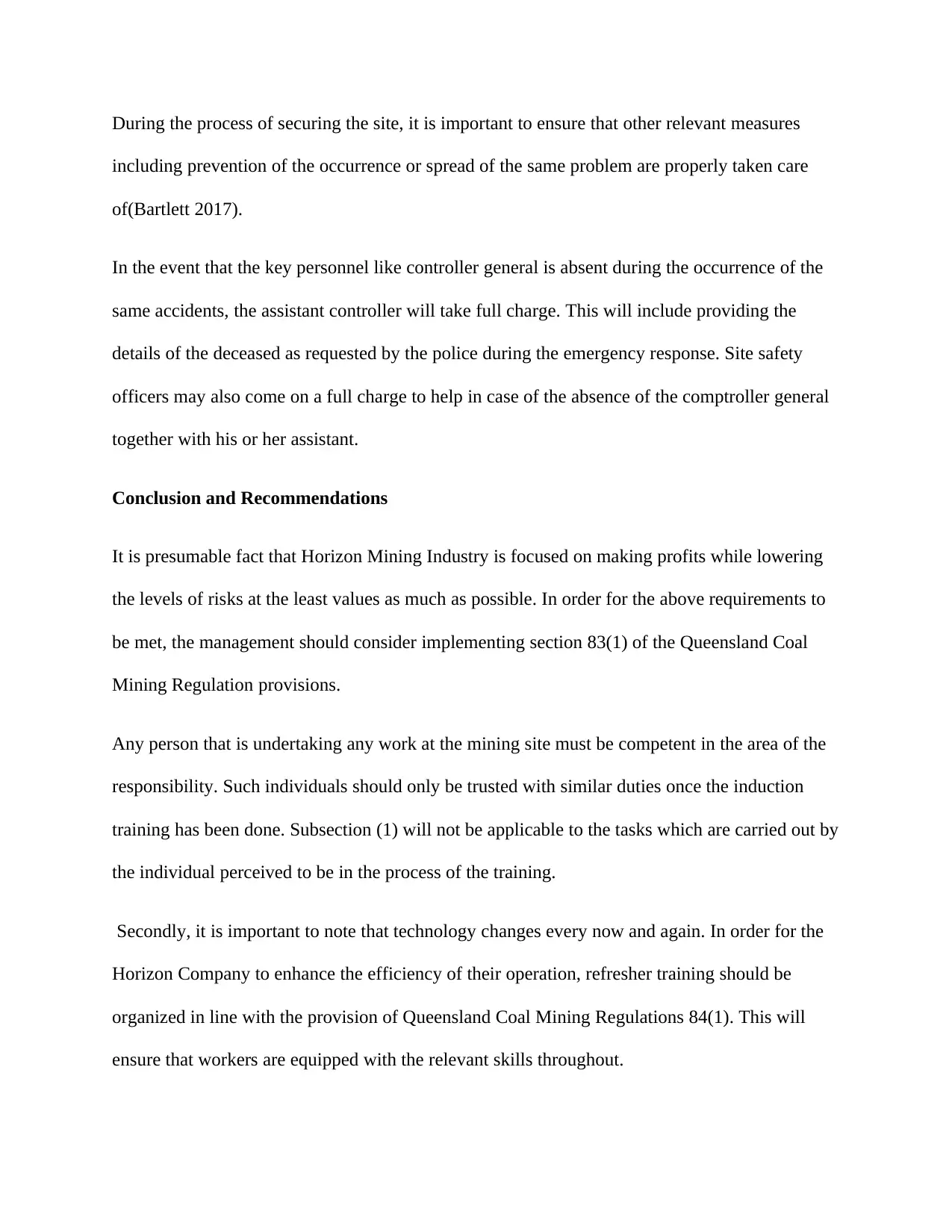
During the process of securing the site, it is important to ensure that other relevant measures
including prevention of the occurrence or spread of the same problem are properly taken care
of(Bartlett 2017).
In the event that the key personnel like controller general is absent during the occurrence of the
same accidents, the assistant controller will take full charge. This will include providing the
details of the deceased as requested by the police during the emergency response. Site safety
officers may also come on a full charge to help in case of the absence of the comptroller general
together with his or her assistant.
Conclusion and Recommendations
It is presumable fact that Horizon Mining Industry is focused on making profits while lowering
the levels of risks at the least values as much as possible. In order for the above requirements to
be met, the management should consider implementing section 83(1) of the Queensland Coal
Mining Regulation provisions.
Any person that is undertaking any work at the mining site must be competent in the area of the
responsibility. Such individuals should only be trusted with similar duties once the induction
training has been done. Subsection (1) will not be applicable to the tasks which are carried out by
the individual perceived to be in the process of the training.
Secondly, it is important to note that technology changes every now and again. In order for the
Horizon Company to enhance the efficiency of their operation, refresher training should be
organized in line with the provision of Queensland Coal Mining Regulations 84(1). This will
ensure that workers are equipped with the relevant skills throughout.
including prevention of the occurrence or spread of the same problem are properly taken care
of(Bartlett 2017).
In the event that the key personnel like controller general is absent during the occurrence of the
same accidents, the assistant controller will take full charge. This will include providing the
details of the deceased as requested by the police during the emergency response. Site safety
officers may also come on a full charge to help in case of the absence of the comptroller general
together with his or her assistant.
Conclusion and Recommendations
It is presumable fact that Horizon Mining Industry is focused on making profits while lowering
the levels of risks at the least values as much as possible. In order for the above requirements to
be met, the management should consider implementing section 83(1) of the Queensland Coal
Mining Regulation provisions.
Any person that is undertaking any work at the mining site must be competent in the area of the
responsibility. Such individuals should only be trusted with similar duties once the induction
training has been done. Subsection (1) will not be applicable to the tasks which are carried out by
the individual perceived to be in the process of the training.
Secondly, it is important to note that technology changes every now and again. In order for the
Horizon Company to enhance the efficiency of their operation, refresher training should be
organized in line with the provision of Queensland Coal Mining Regulations 84(1). This will
ensure that workers are equipped with the relevant skills throughout.
Secure Best Marks with AI Grader
Need help grading? Try our AI Grader for instant feedback on your assignments.
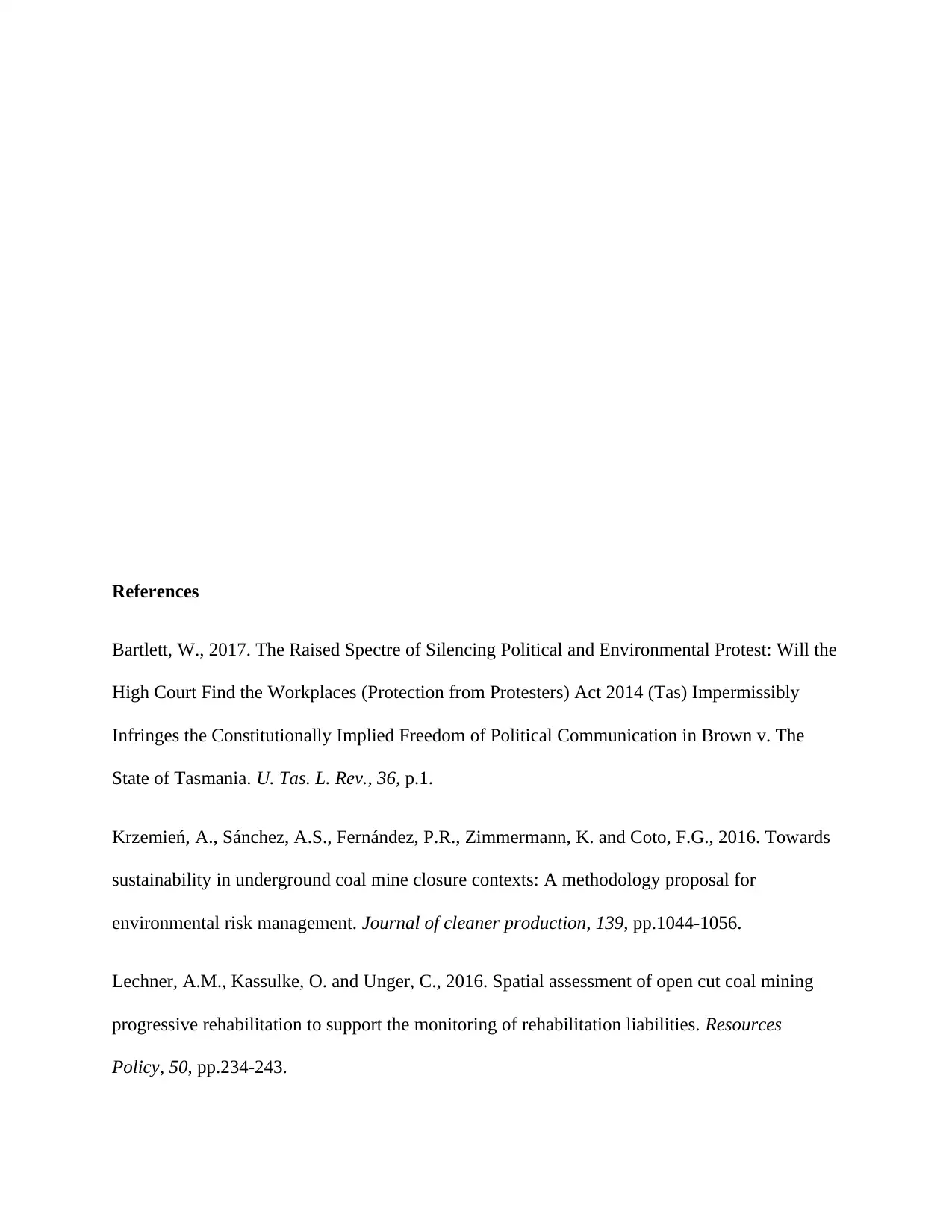
References
Bartlett, W., 2017. The Raised Spectre of Silencing Political and Environmental Protest: Will the
High Court Find the Workplaces (Protection from Protesters) Act 2014 (Tas) Impermissibly
Infringes the Constitutionally Implied Freedom of Political Communication in Brown v. The
State of Tasmania. U. Tas. L. Rev., 36, p.1.
Krzemień, A., Sánchez, A.S., Fernández, P.R., Zimmermann, K. and Coto, F.G., 2016. Towards
sustainability in underground coal mine closure contexts: A methodology proposal for
environmental risk management. Journal of cleaner production, 139, pp.1044-1056.
Lechner, A.M., Kassulke, O. and Unger, C., 2016. Spatial assessment of open cut coal mining
progressive rehabilitation to support the monitoring of rehabilitation liabilities. Resources
Policy, 50, pp.234-243.
Bartlett, W., 2017. The Raised Spectre of Silencing Political and Environmental Protest: Will the
High Court Find the Workplaces (Protection from Protesters) Act 2014 (Tas) Impermissibly
Infringes the Constitutionally Implied Freedom of Political Communication in Brown v. The
State of Tasmania. U. Tas. L. Rev., 36, p.1.
Krzemień, A., Sánchez, A.S., Fernández, P.R., Zimmermann, K. and Coto, F.G., 2016. Towards
sustainability in underground coal mine closure contexts: A methodology proposal for
environmental risk management. Journal of cleaner production, 139, pp.1044-1056.
Lechner, A.M., Kassulke, O. and Unger, C., 2016. Spatial assessment of open cut coal mining
progressive rehabilitation to support the monitoring of rehabilitation liabilities. Resources
Policy, 50, pp.234-243.
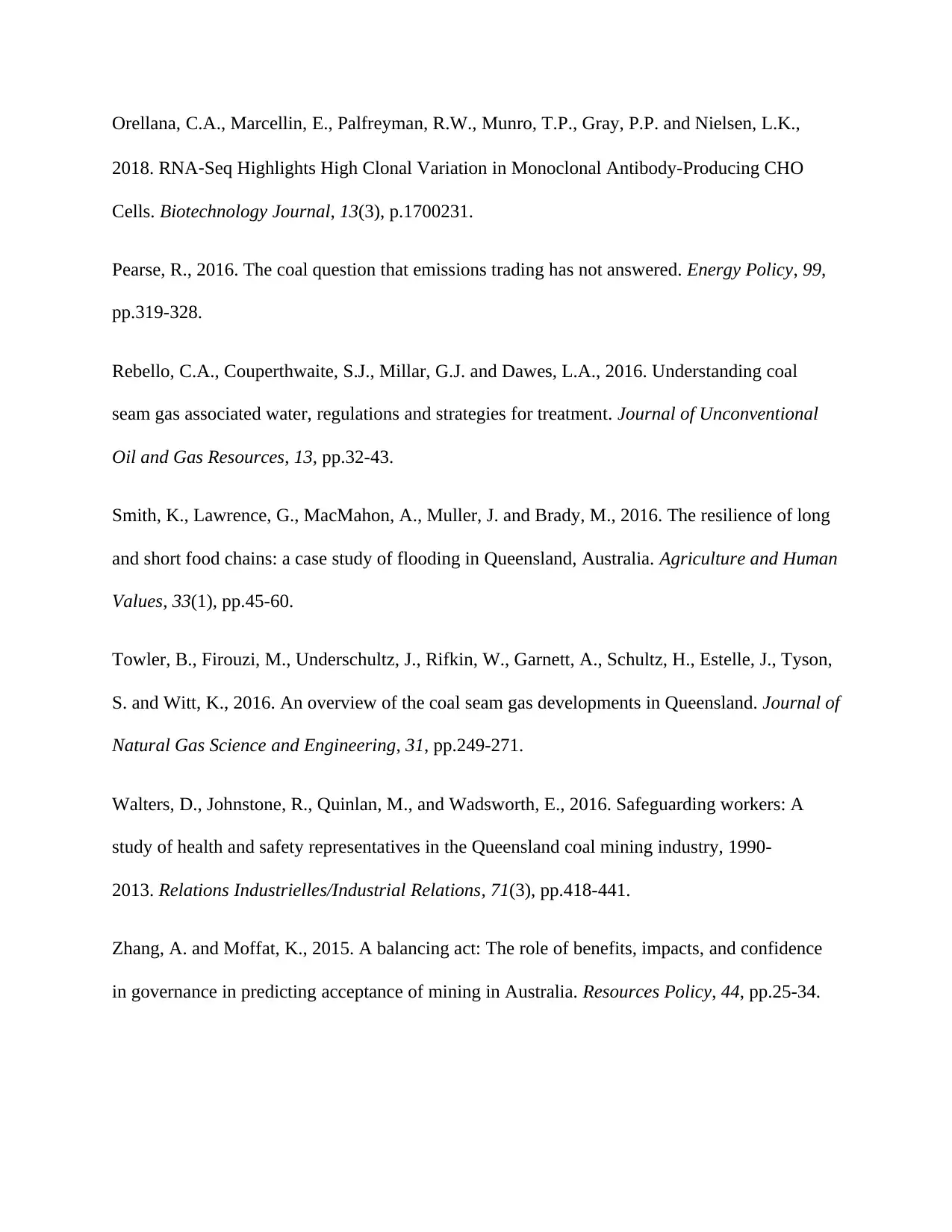
Orellana, C.A., Marcellin, E., Palfreyman, R.W., Munro, T.P., Gray, P.P. and Nielsen, L.K.,
2018. RNA‐Seq Highlights High Clonal Variation in Monoclonal Antibody-Producing CHO
Cells. Biotechnology Journal, 13(3), p.1700231.
Pearse, R., 2016. The coal question that emissions trading has not answered. Energy Policy, 99,
pp.319-328.
Rebello, C.A., Couperthwaite, S.J., Millar, G.J. and Dawes, L.A., 2016. Understanding coal
seam gas associated water, regulations and strategies for treatment. Journal of Unconventional
Oil and Gas Resources, 13, pp.32-43.
Smith, K., Lawrence, G., MacMahon, A., Muller, J. and Brady, M., 2016. The resilience of long
and short food chains: a case study of flooding in Queensland, Australia. Agriculture and Human
Values, 33(1), pp.45-60.
Towler, B., Firouzi, M., Underschultz, J., Rifkin, W., Garnett, A., Schultz, H., Estelle, J., Tyson,
S. and Witt, K., 2016. An overview of the coal seam gas developments in Queensland. Journal of
Natural Gas Science and Engineering, 31, pp.249-271.
Walters, D., Johnstone, R., Quinlan, M., and Wadsworth, E., 2016. Safeguarding workers: A
study of health and safety representatives in the Queensland coal mining industry, 1990-
2013. Relations Industrielles/Industrial Relations, 71(3), pp.418-441.
Zhang, A. and Moffat, K., 2015. A balancing act: The role of benefits, impacts, and confidence
in governance in predicting acceptance of mining in Australia. Resources Policy, 44, pp.25-34.
2018. RNA‐Seq Highlights High Clonal Variation in Monoclonal Antibody-Producing CHO
Cells. Biotechnology Journal, 13(3), p.1700231.
Pearse, R., 2016. The coal question that emissions trading has not answered. Energy Policy, 99,
pp.319-328.
Rebello, C.A., Couperthwaite, S.J., Millar, G.J. and Dawes, L.A., 2016. Understanding coal
seam gas associated water, regulations and strategies for treatment. Journal of Unconventional
Oil and Gas Resources, 13, pp.32-43.
Smith, K., Lawrence, G., MacMahon, A., Muller, J. and Brady, M., 2016. The resilience of long
and short food chains: a case study of flooding in Queensland, Australia. Agriculture and Human
Values, 33(1), pp.45-60.
Towler, B., Firouzi, M., Underschultz, J., Rifkin, W., Garnett, A., Schultz, H., Estelle, J., Tyson,
S. and Witt, K., 2016. An overview of the coal seam gas developments in Queensland. Journal of
Natural Gas Science and Engineering, 31, pp.249-271.
Walters, D., Johnstone, R., Quinlan, M., and Wadsworth, E., 2016. Safeguarding workers: A
study of health and safety representatives in the Queensland coal mining industry, 1990-
2013. Relations Industrielles/Industrial Relations, 71(3), pp.418-441.
Zhang, A. and Moffat, K., 2015. A balancing act: The role of benefits, impacts, and confidence
in governance in predicting acceptance of mining in Australia. Resources Policy, 44, pp.25-34.
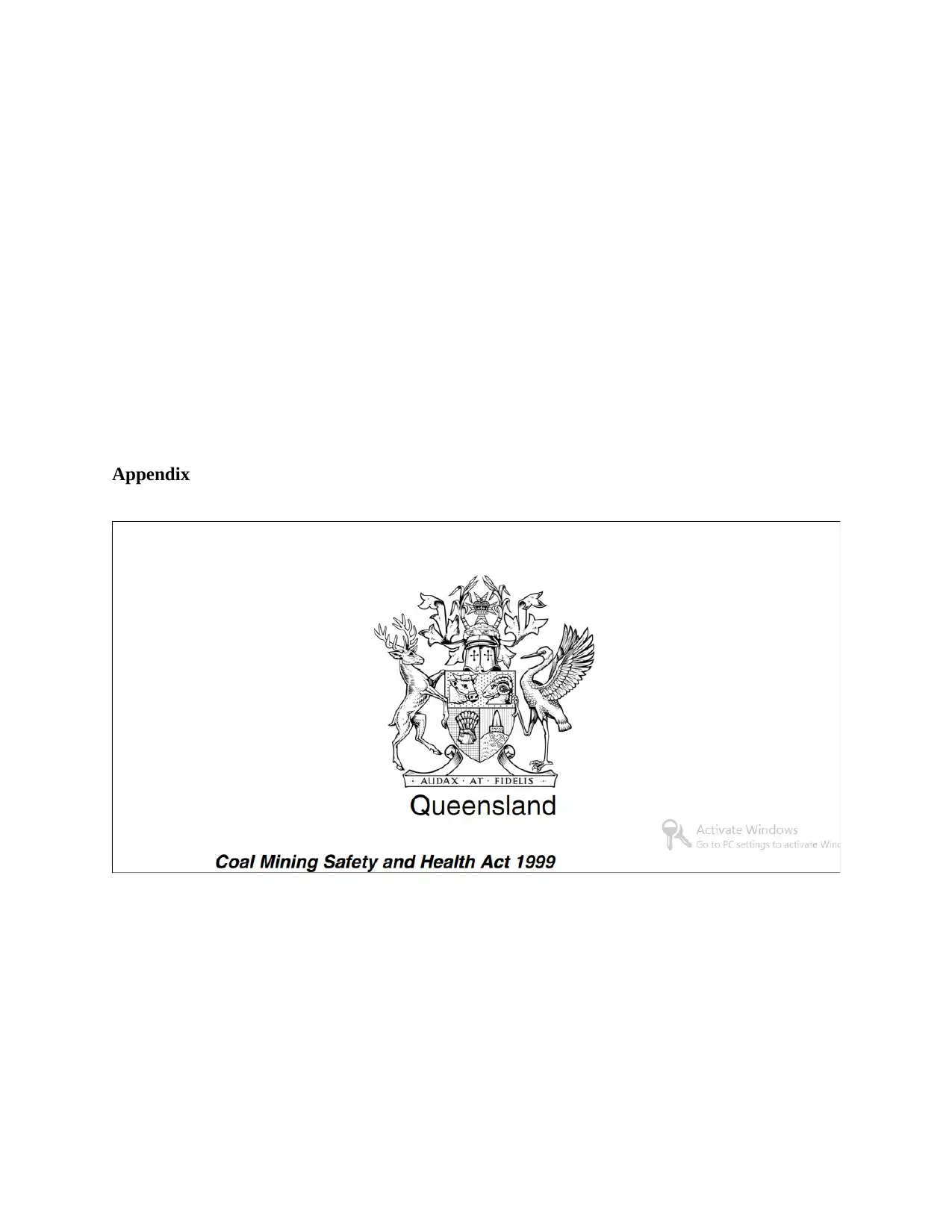
Appendix
Paraphrase This Document
Need a fresh take? Get an instant paraphrase of this document with our AI Paraphraser
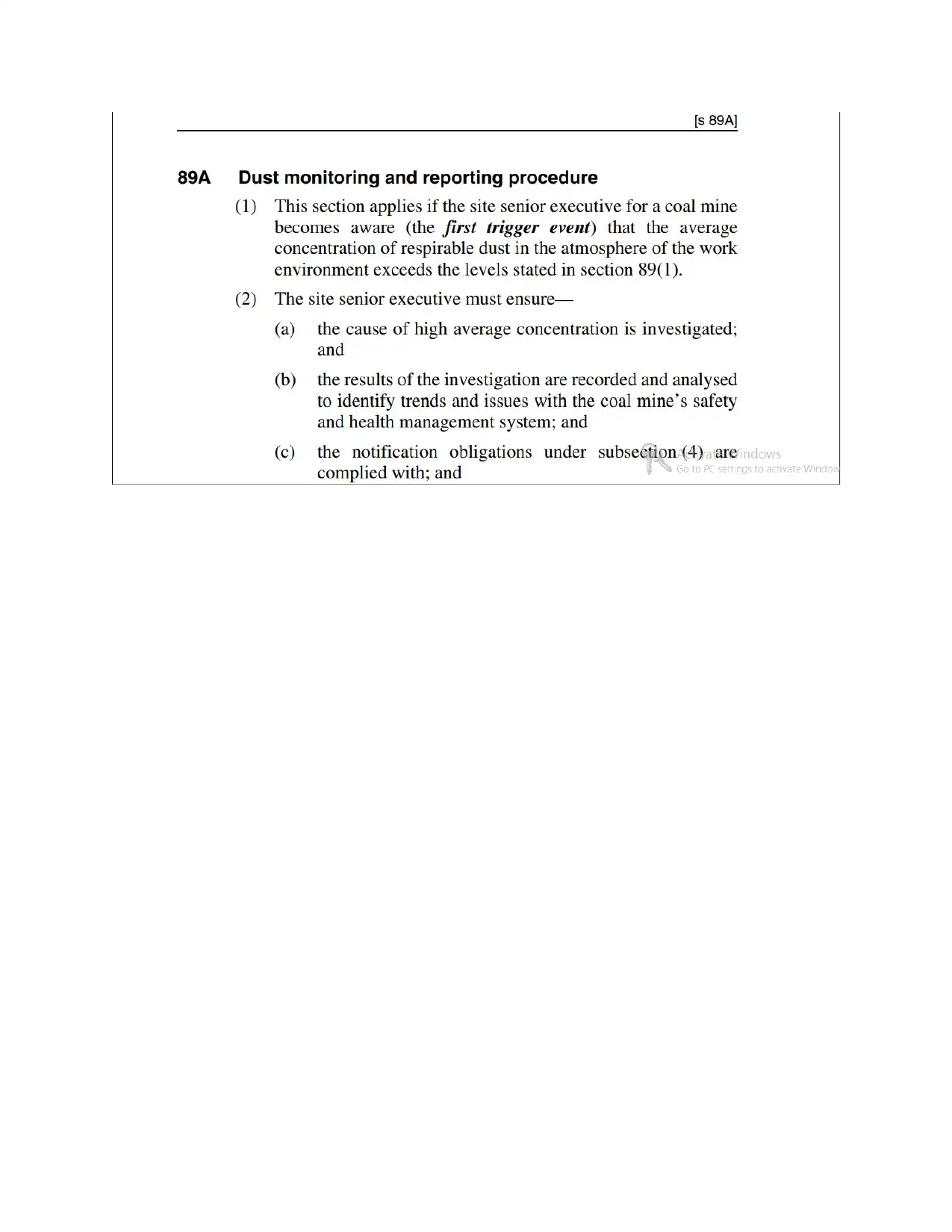
1 out of 14
Related Documents
Your All-in-One AI-Powered Toolkit for Academic Success.
+13062052269
info@desklib.com
Available 24*7 on WhatsApp / Email
![[object Object]](/_next/static/media/star-bottom.7253800d.svg)
Unlock your academic potential
© 2024 | Zucol Services PVT LTD | All rights reserved.





